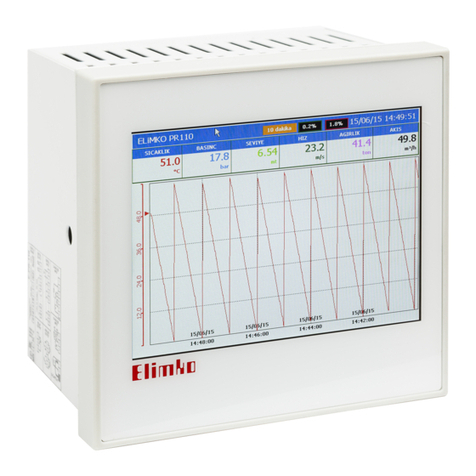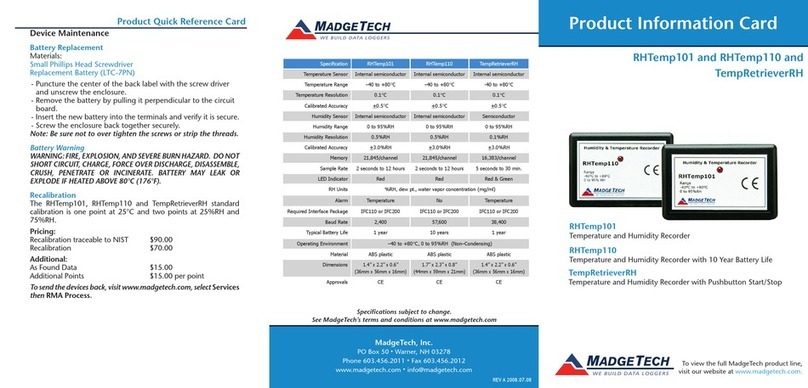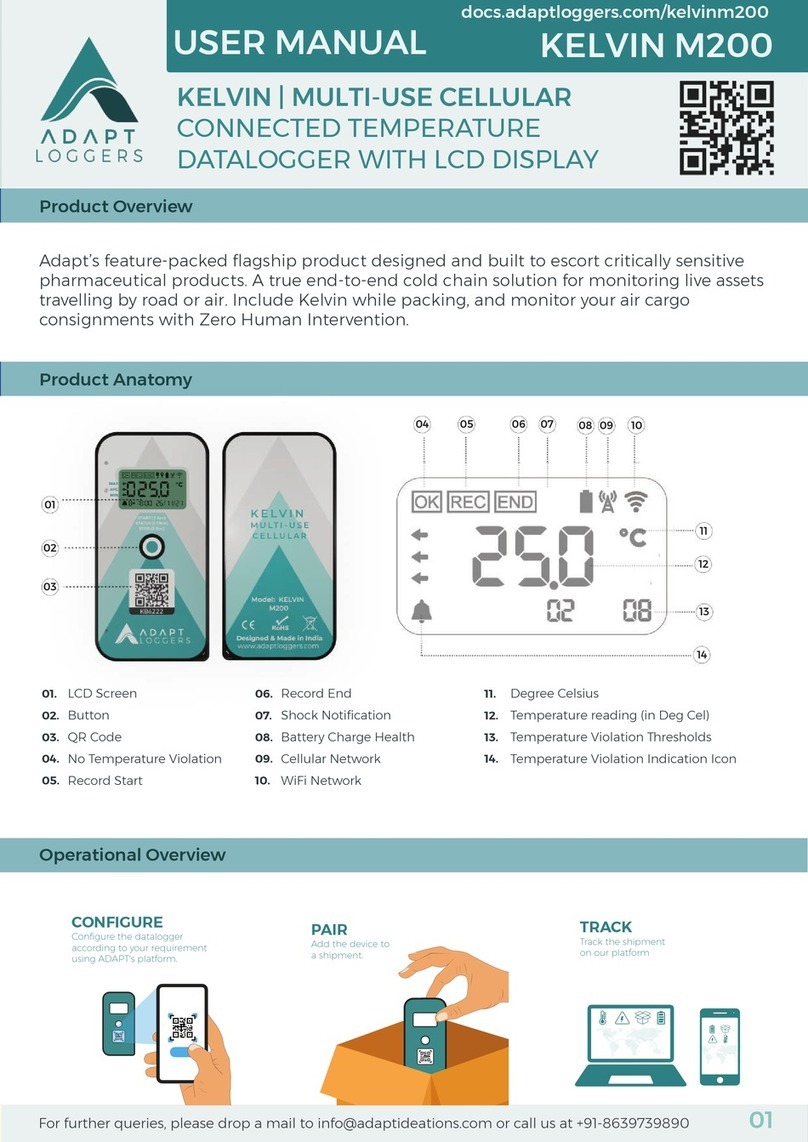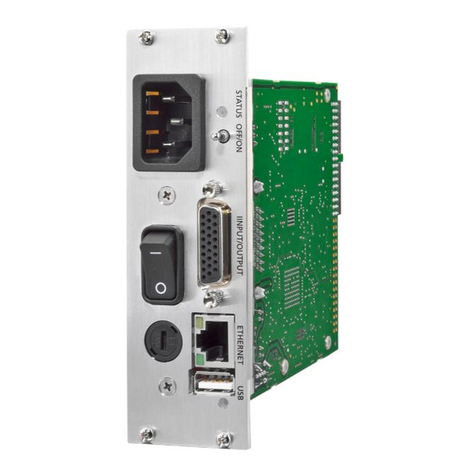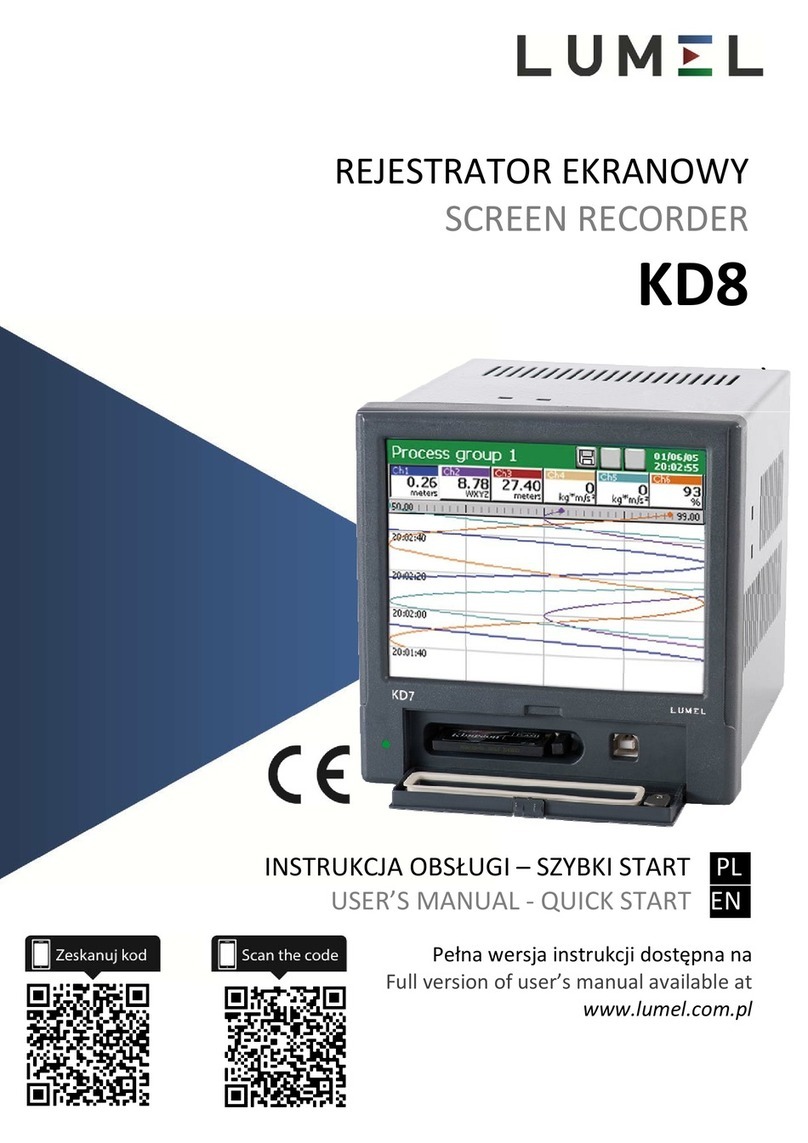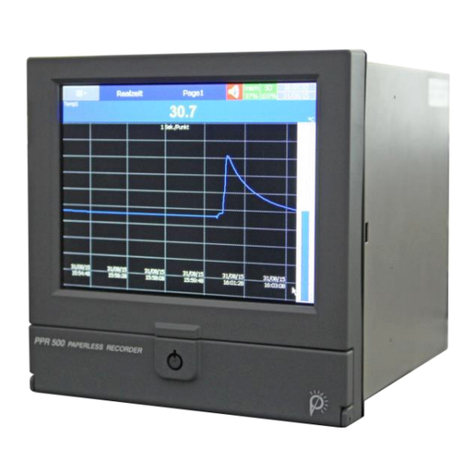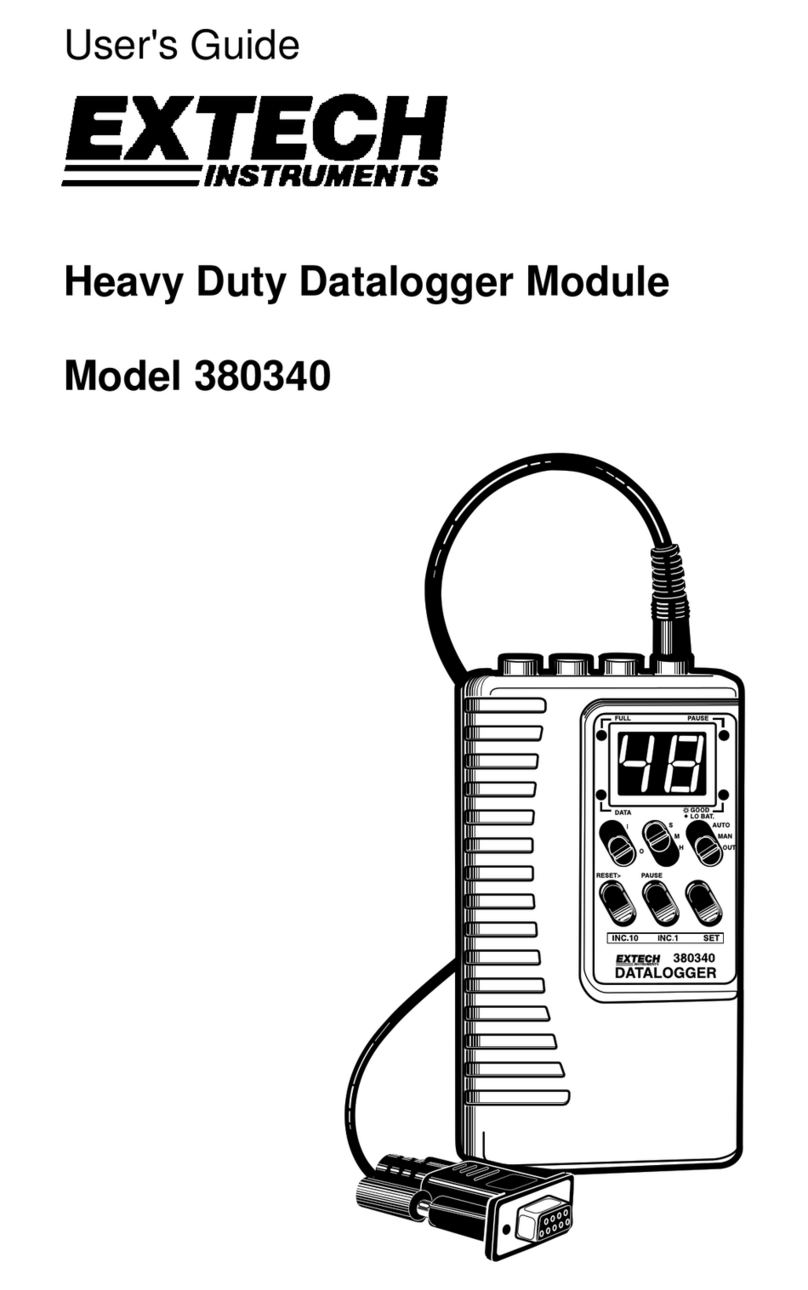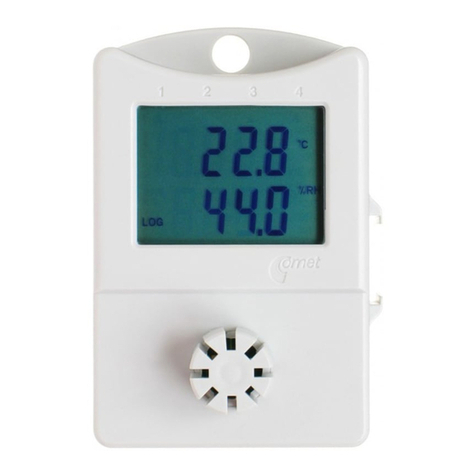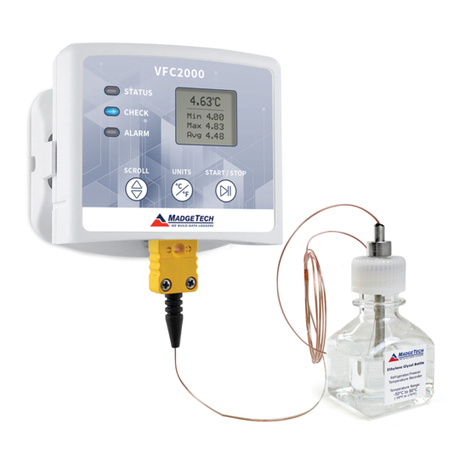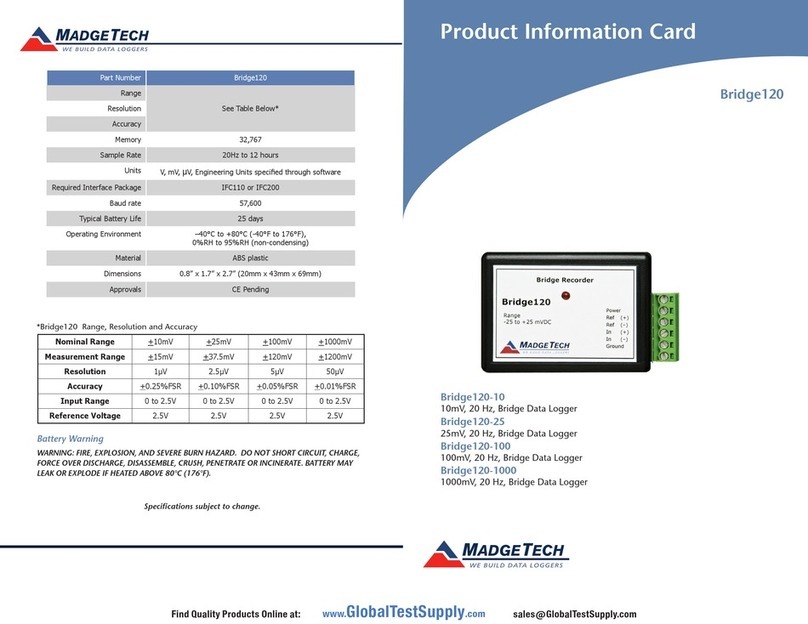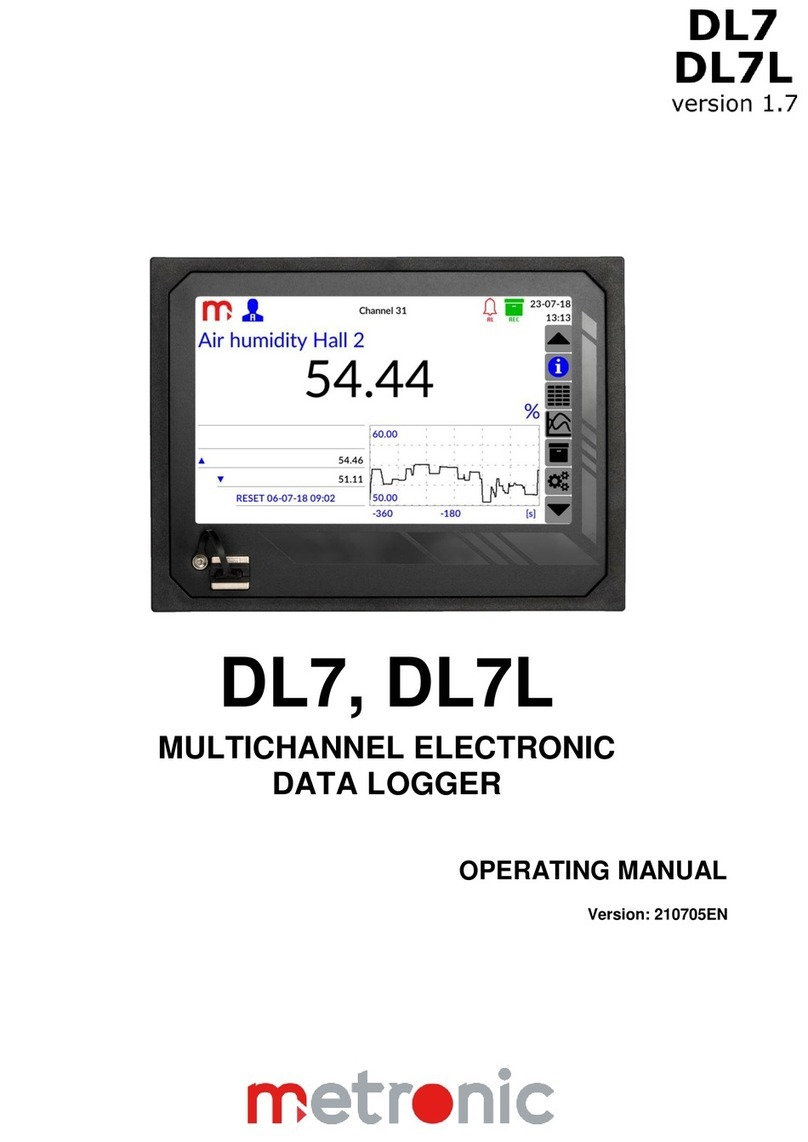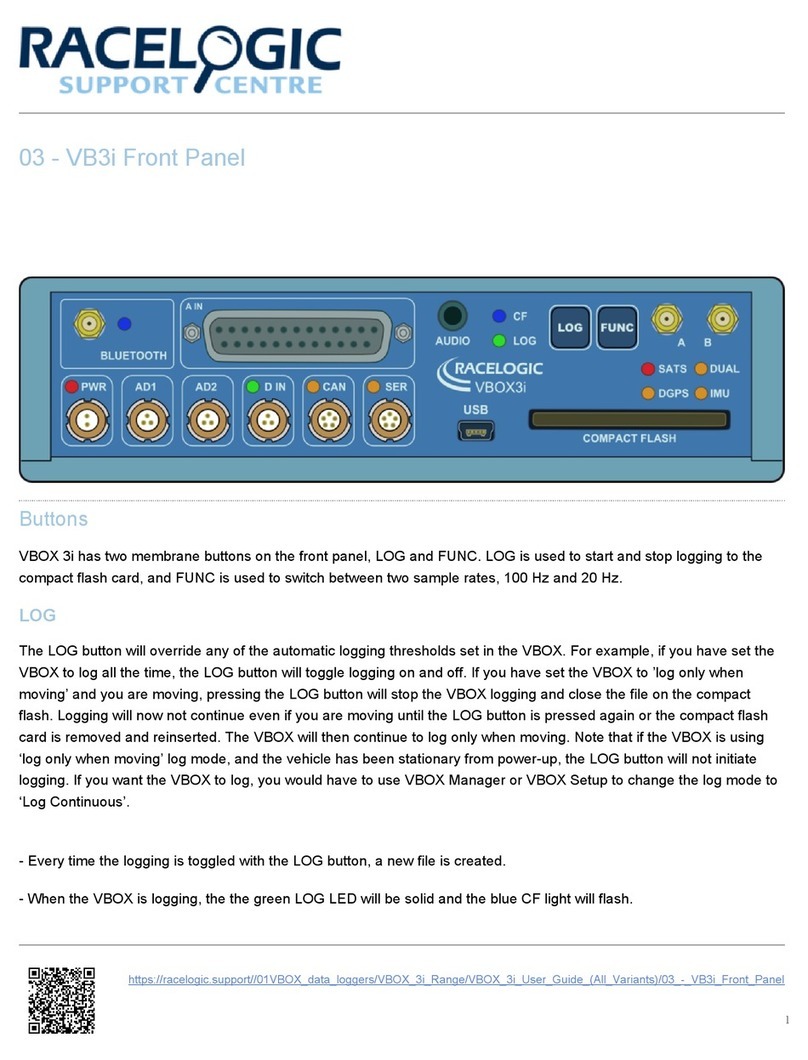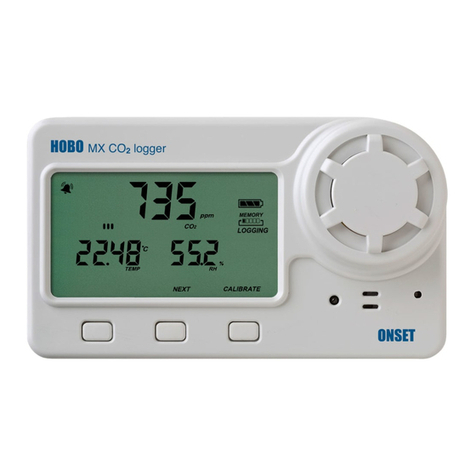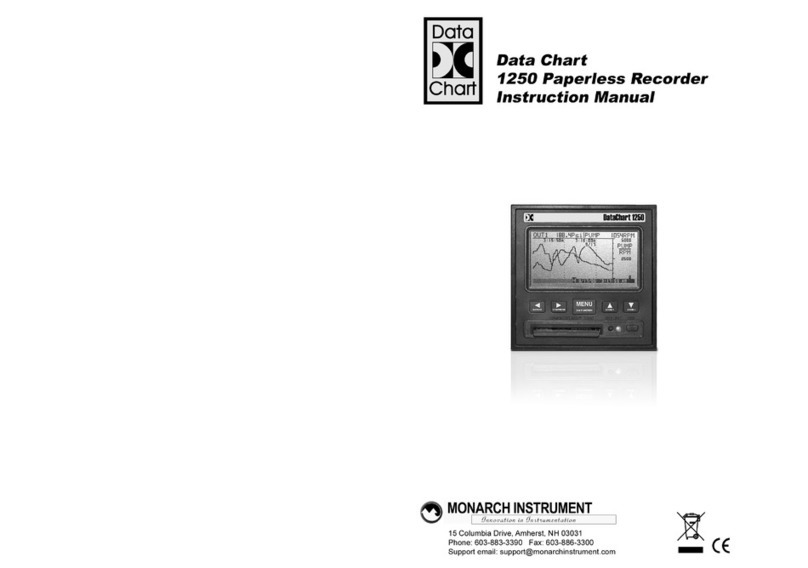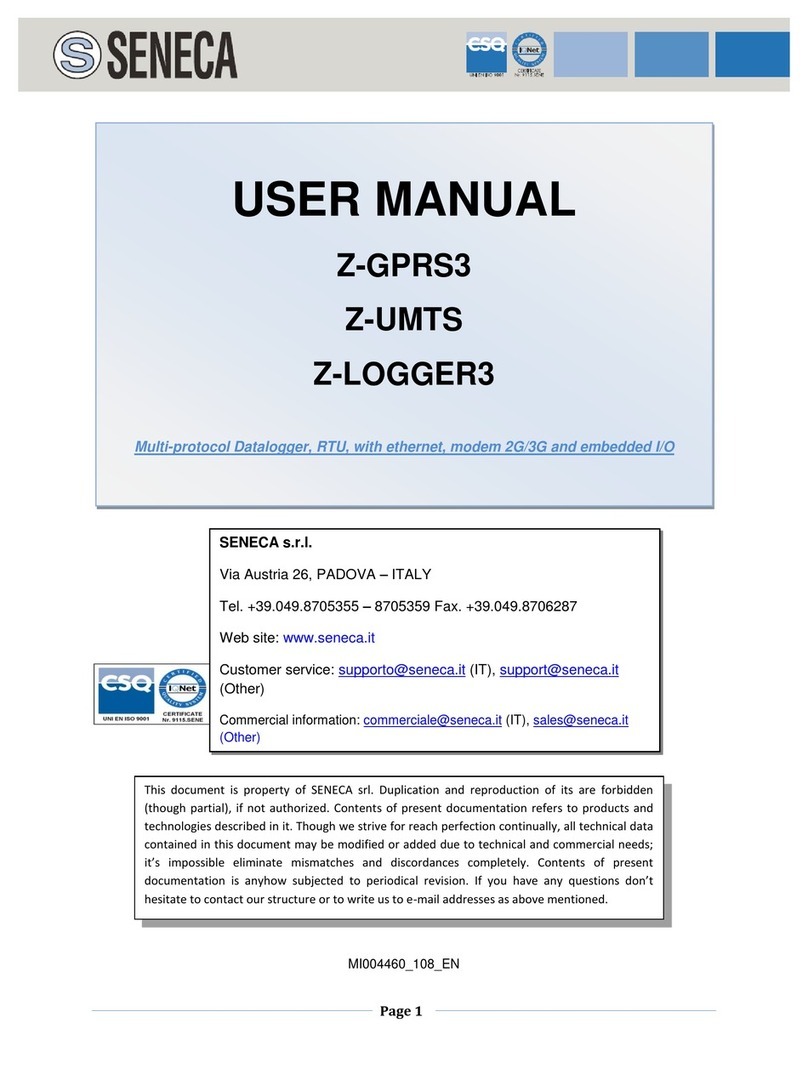Elimko E-680 Series User manual

E-680
E-680 scanners / data loggers are designed for panel mounting and should be used in an industrial environment.
The package of E-680 device contains;
Device
2 pieces of mounting clamps
User manual
Guarantee certificate
After opening the package, please check the contents with the above list. If the delivered product is wrong type, any
item is missing or there are visible defects, contact the vendor from which you purchased the product.
Before installing and operating the device, please read the user manual thoroughly.
The installation and configuration of the controller must only be performed by a person qualified in instrumentation.
Keep the unit away from flamable gases, that could cause explosion.
It is not used in medical applications.
Do not use alcohol or other solvents to clean the device. Use a clean cloth soaked in water tightly squeezed to
gently wipe the outer surface of the device.
EU DIRECTIVE COMPLIANCE
Low Voltage Directive
EN 61010-1
EMC Directive
EN 61326-1
KY-680-1123-1
680
Elimko
CHANNEL MEASUREMENT ALARM
SET2
SET1
Program
Manual
Set1
Set2
A/M
E-680 Series
Universal Data Loggers / Scanners
User Manual
32 680.0 c#
Elimko Elektronik İmalat ve Kontrol Ltd. Şti.
8. Cadde 21. Sokak No:16 Emek 06510 Ankara / TÜRKİYE
Telefon: + 90 312 212 64 50 Faks: + 90 312 212 41 43
www.elimko.com.tr • e-mail:[email protected]
Manufacturer / Technical Support
E-680
1
1. Introduction....................................................................................................................................................................
1.1. Technical Specifications............................................................................................................................................
1.2. Type Coding..................................................................................................................................................................
1.3. Dimensions...................................................................................................................................................................
1.4. Panel Mounting.............................................................................................................................................................
2. Usage................................................................................................................................................................................
2.1. General.....................................................................................................................................................................
2.2. Configuration Pages...................................................................................................................................................
2.2.1. General Configuration Page............................................................................................................................
2.2.2. Alarm Configuration Page................................................................................................................................
2.2.3. Input Configuration Page.................................................................................................................................
2.2.4. Security Configuration Page................................................................................................................................
2.2.5. Calibration Page.............................................................................................................................................
2.3. Warning Messages.....................................................................................................................................................
2.4. E-680 Connection Diagrams.................................................................................................................................
2.5. E-680 Jumper Settings..........................................................................................................................................
2.6. E-680 Communication Connection.............................................................................................................................
Index
2-3
4-5
6
7
8
9-12
13
14-16
17-19
20-25
26
9
27-30
31
32-35
36-37
38

E-680
2
Program
Set2
Set1
Program
ALARMMEASUREMENTCHANNEL
Manual
A/M
SET2
SET1
680
El imko
1. Introduction
E-680 series universal data loggers / scanners are advanced new generation microcontroller based industrial instruments,
dimensions of 96×192 mm compatible with IEC/TR 60668 standards. Universal inputs and outputs of the device can be
programmed easily by the user. E-680 series indicate measurements from 32 different points on instrument display and
determines alarm conditions according to the result of comparison of two set points for each channel. The alarm conditions
can be directed to the common alarm relays and / or to the independent relays. The instruments can be connected to an
RS-485 communication line and the data can be collected and stored in a centrally located PC.
Figure 1.1. E-680 front view
(continue on next page)
32 680.0 c
E-680
E-680
3
1. Introduction
High reading sensivity with 16 bit resolution
Infinite life time and high isolation voltage semiconductor multiplexer relay
Standart RS-485 Modbus communication interface
2 common alarm relays and 16 independent alarm relay output
Up to 2 configurable analog outputs for retransmission output
Each channel can be programmed independently
2 set points for each input
Possibility of defining alarm types for each set point
Possibility of defining hysteresis for each set point
Directing alarm states to a common or independent relay
Programmable display and scan intervals
Flow rate calculation with compansation up to 10 channels
Arithmetic operations (add, subtract, multiply or divide with a constant ) on physical channels
Possibility of connecting up to 31 instruments to a PC by the same communication line
Distributed system structure
1.1. Technical Specification
Input Types
Display Resolution
Display Type
Alarm Outputs
1/9999
Thermocouple: B, E, J, K, L, N, R, S, T, U Resistance Thermometer: Pt-100, CUST
Voltage: 0-50 mV, 0-1 V, 0.2-1 V, 0-10 V (Linear) Current: 0-20 mA, 4-20 mA (Linear)
Thermocouple: ( ±%0.5 or ±1ºC of indicated value) ±1 digit max.
9 digit, 14mm 7 segment led display
SPST-NO 250 V AC 3A relay
4
120 dB at 50 Hz
Display Scan Time
Noise Suppression
1-99 sec.
Accuracy
Analog Digital Converter
Digital Analog Converter
Input Scan Time
16 bit
12 bit
Pt-100: ( ±%0.5 or ±1ºC of indicated value) ±1 digit max.
Voltage/Current: ±%0.5 FS ±1 digit max.
0.2-9.9 sec.
(continue on next page)

E-680
E-680
5
6
1.1. Technical Specification
85-265 V / 85-375 V
AC DC
20-60 V / 20-85 V
AC DC
4 W (7 VA)
IP 66 Front Panel (NEMA 4X)
IP 20 Rear Case
0ºC-50ºC
650 g
-25ºC, +65ºC (-13ºF, +149ºF) (With no condensation or icing)
NA Contact 250 V 3 A
AC
5
EEPROM max. 10 writing
Operating Temperature
Storage Temperature
T/C Temperature Compansation
Power Supply
Power Consumption
Relay Electrical Life
Memory
Contact Capacity
Relay Mechanical Life
Weight
10.000.000 operation*
>1.000.000 operation (1/10 load)
Protection Class
-10ºC, +55ºC (14ºF, 131ºF) (With no condensation or icing)
* The relay life differs according to the usage configuration. When the relays are old, their contacts could melt or burn out.
1.2. Type Coding
Coding Example:
E-680-16-2-0-08-1-0
- 16 input, 2 common relay
- 8 independent relay output
- RS-485 communication
- 85-265 V / 85-375 V supply
AC DC
Note: XX must be codded as ‘0’
for devices having more than 16
channels.
680 UU V W XX Y Z– – - - - – -
Power Supply
0 : 85-265 V / 85-375 V
AC DC
1 : 20-60 V / 20-85 V
AC DC
Communication
0 : None
1 : RS-485 Modbus
Number of Independent Relay (00-16)
Common Relay Output
0 : None
1 : 1 Relay
2 : 2 Relay
Number of Inputs (01-32)
Analog Output
0 : None
1 : 1 Analog Output
2 : 2 Analog Outputs
E-680
7
1.3. Dimensions
Note: Drawings are not in real scale. Do not use for scaling.
3 mm 11 mm
93 mm
96 mm
192 mm
Set2
Set1
Program
ALARM
Manual
CHANNEL
A/M
SET2
SET1
680
Eli mko
MEASUREMENT
32 680.0 c

E-680
8
There are three clamp holes located at the
top and the bottom side of the device. Use the
convenient ones and fit the mounting clamps to
the controller ensuring the lugs are located in their
slots.
1.4 Panel Mounting
E-680 controller should be installed inside a suitable grounded metal enclosure (panel). This must prevent
the live parts being accessible to human hands and metal tools.
E-680 controller does not include a power switch. Therefore, the power supply of the controller and power
outputs must be wired through the proper fuse or circuit breaker.
To minimize the pick-up of electrical noise, the wiring of low voltage lines, particularly the sensor inputs should be routed
away from the high-current power cables. If this is not possible use screened cables and apply grounding.
The cables used for powering the controller and the power outputs must conform to the standarts IEC 60245 and IEC 60227.
Cut a hole in the panel. (See the figure for
overall dimensions.)
Slide the controller into the cutout from the
front of the panel.
Fasten the mounting clamps using the retaining screws.
25 mm min.
100 mm min.
-0.0
+0.5
184 x 89 mm
Figure 1.2.
Panel Cutout and
Minimum Spacing
E-680
E-680
9
10
Set2
Set1
Program
ALARM
Manual
A/M
SET2
SET1
680
El imko
CHANNEL MEASUREMENT
2.1 General
2. Usage
9 digit led display
Program : Lights while in
configuration mode.
Manual : Lights in manual
mode.
Set 1: Lights during Set 1
common alarm.
Set2 : Lights during Set 2
common alarm.
and buttons : Used to change
channel number during manual
mode, page and parameter values
during configuration mode.
button : Used to access
to the alarm page in normal
mode, and to pass between
parameters in configuration
mode.
button : Used to
escape the menus. Also
when pressed with
configuration level is
reached.
button : Used to toggle
between automatic and
manual mode.
(continue on next page)
The front panel is formed by 9 digit 7 segment led display, Program, Manual, Set 1, Set 2 leds and , , , ,
button which are used for programming and manual controls. Program led lights when entered to the configuration
mode, and Manual led lights during Manual mode, Set 1 led lights during SET 1 common alarm and Set 2 led lights
during SET 2 common alarm period. During normal mode, channel numbers are displayed in the first two digits,
measured values in the digits 4-7 and alarm information in the last digit of the 9 digit LED display. Channel information
can be watched automatically or manually. In automatic mode, channel information can be monitored consecutively.
The display time of a channel data is equal to GA parameter in seconds. button is used for switching from automatic
to manual or manual to automatic mode. In manual mode only one channel can be monitored, channel number is
selected by and buttons.
2.1 General
Figure 2.1. Operator Page
CHANNEL ALARM
SET2
SET1
MEASURED
VALUE
(continue on next page)
32 680.0 c
16 255.4 c

E-680
E-680
11
12
2.1 General
When the device is in normal operation state, the button can be used
to switch to the totalizer and the alarm pages. When the device is in
manual mode and the button is pressed, totalizer value is displayed.
In this page, simultaneously pressing and buttons reset totalizer.
Next to the totalizer page, alarm pages are reached. All alarms (Set 1,
Set 2) can be seen together in these pages. In the first alarm page,
alarms of the channels 1 to 16 are displayed and letter A is shown in the
last digit. In the second alarm page, alarms of channels 17 to 32 are
displayed and letter B is shown in the last digit. In the third alarm page,
status of the output relays R1 to R16 are displayed and letter O is shown
in the last digit. Figure 2.2. shows the display format of the alarm pages.
While in the totalizer or alarm pages pressing the button reverts to the
normal operation page. Alarm status of the channel which are not active
or closed for scanning are shown as empty.
(continue on next page)
Normal Operation State
Totalizer
(Only in manual
mode)
Auto. / Manual
Toggling
Alarm Page
1-16
Alarm Page
17-32
Relay Page
1-16
2.1 General
Figure 2.2. Alarm Pages
SET 1 alarm for the channels 1,2,3,5,7,8,9,11,13,14 and 15
SET 2 alarm for the channels 1,2,3,5,7,13 and 14
SET2
SET1
CHANNEL ALARM
MEASURED
VALUE
SET 1 alarm for the channels 17,18,19,21,23,24,25,27,29,30 and 31
SET 2 alarm for the channels 17,18,19,21,23,29 and 30
SET2
SET1
CHANNEL ALARM
MEASURED
VALUE
Output relays 1,3,5,6,7,13,15 are energized.
SET2
SET1
CHANNEL ALARM
MEASURED
VALUE
abdaddddA
654654654
abdaddddB
abdaddddO
01 100.0 c
abdgkkakA
abdgkkakB
ddad ddO
E-680
13
2.2 Configuration Pages
CoD= 0
PAGE= GCNF
Normal
Operation State
Parameters
Configuration
Password
$999 - 9999
GCNF, ACNF,ICNF
PRTC, CLBR
Configuration
Pages
When the device is in the normal operation state, pressing the and
buttons simultaneously enters the configuration mode. When the
configuration mode is entered, “COD” message is displayed for the
security code. Security code is entered by using the buttons and .
The factory setting of the security code is “10”. If the correct code is
entered, the user is authorized to change all the device settings including
the calibration. Otherwise, the rights are only restricted to the settings of
the “PRTC” page. After this process, PAGE = is written to first 5 digit of
display and the name of the page is displayed in the last 4 digit. To pass
between menus the and buttons are used. In order to return to the
normal operation state, the button should be pressed. In order to
access to any configuration page, the button is used and by pressing
this button, the parameters in this page are displayed one by one. In this
step, the parameter name is indicated in the first 4 digits of the display,
and the parameter value is indicated in the last 4 digit of led display. In
order to change the parameter values, the and buttons are used. To
exit from any page the button is used.
Configuration Pages

E-680
14
2.2.1 General Configuration Page
(continue on next page)
GENERAL CONFIGURATION PAGE
Display Interval (1 - 99 sec) : Channel information display time in automatic mode.
Scan Time (0.2 - 9.9 sec) : The sampling time of the channels.
Number of Channel (1 - 32) : The total number of the physical and the virtual channels. The
virtual channels are used for the results of the arithmetic operation (add, subtract, etc.) on the
physical channels
Number of Analog Inputs (1 - KS) : Indicates the number of inputs that will be used. Number of
inputs shouldn’t be more than 16 for the devices containing relay card. Otherwise relay card will
not be functional.
Temperature Unit (*C / *F) : Indicates the measuring unit of TC and RT inputs. It will be inactive
for other inputs..
UN1T
C
=
Ks
PAGE GCNF
=
16
GA 1
=
TA 0.5
=
=
GS 16
=
E-680
E-680
15
16
2.2.1 General Configuration Page
Device Communication Address (1 - 31)
Communication Speed (9.6 /19.2 / 38.4) : Indicates the number of bits that will be sent in one
second as 1000.
Control Type 1 (PULS / CONT) :
PULS : When an alarm is detected, relay RO1 energized for a duration of PLNG.
CONT : While in alarm state, RO1 energized continuously.
Control Type 2 (PULS / CONT) :
PULS : When an alarm is detected, relay RO2 energized for a duration of PLNG.
CONT : While in alarm state, RO2 energized continuously.
Number of Repeat (0 -12) : Determines the number of scan that is required before any alarm
indication.
RP
BAUD
CT2
CONT
=
0
EVEN
38.4
PRTY
Ct1 CONT
=
=
=
=
1
=
ADrs
Parity (NONE / ODD / EVEN) : Determines the communication parity
(continue on next page)
Pulse Length (1 - 2 sec) : If control type is selected as PULS, this parameter determines the
energizing period of the alarm relay
AO2S 1
=
1AO1S
=
AO1R 4-20
=
1
=
PLNG
AO2R 4-20
=
2.2.1 General Configuration Page
1. Analog Output Range (0-20, 20-0, 4-20, 20-4)
1. Analog Output Source (1 - Ks ) : Determines the number of the channel to be retransmitted
from 1. Analog Output.
2. Analog Output Range (0-20, 20-0, 4-20, 20-4)
2. Analog Output Source (1 - Ks ) : Determines the number of the channel to be retransmitted
from 2. Analog Output.

E-680
E-680
17
18
2.2.2 Alarm Configuration Page
(continue on next page)
ALARM CONFIGURATION PAGE
Channel Number (1 - KS) : Determines the channel number which will be configured.
Alarm 1 Set Point (ZERO / SPAN)
Alarm 1 Hysteresis (0 - 9999)
Alarm 1 Type (OFF / LO1 / HI1 / LO2 / HI2 / LO12 / HI12) : If CHNO 16 then choices LO2, HI2,
LO12 and HI12 are not available.
Alarm 1 Relay No : It determines which independent relay will be energized at alarm condition.
Different alarms can be forwarded to the same independent relay. If CHNO 16 and A1TP
selected as Lo2, Hi2, Lo12 or Hi12 this parameter can be accessed.
A1RL
PAGE = ACNF
RL01
CHNO 1
=
A1sP 100
=
A1HY 0
=
A1TP LO1
=
=
2.2.2 Alarm Configuration Page
Alarm 2 Hysteresis (0 - 9999)
Alarm 2 Type (OFF / LO1 / HI1 / LO2 / HI2 / LO12 / HI12) : If CHNO 16 then choices LO2, HI2,
LO12 ve HI12 are not available.
Alarm 2 Relay No : It determines which independent relay will be energized at alarm condition.
Different alarms can be forwarded at the same time independent relay. If CHNO 16 and A2TP
selected as LO2, HI2, LO12 or HI12 this parameter can be accessed.
Alarm 2 Set Point (ZERO / SPAN)
A2TP
A2RL
A2HY
Chno=Chno+1
A2SP
100
=
0
=
LO1
RL01
=
=
(continue on next page)
E-680
19
The alarm types and the principle of generating alarms are
given in the figure on the right. Alarm parameters are RP, CT1,
CT2, PLNG, A1SP, A1HY, A1TP, A1RL, A2SP, A2HY, A2TP and
A2RL.For each channel, set points A1SP and A2SP are
defined. Those can be directed to common and independent
alarm relays according to the values selected for A1TP and
A2TP. When A1TP and A2TP is selected as OFF, the alarms
will not be activated. When alarm type is choosen as LO1 or
HI1 related alarm can only be directed to common alarm relays.
Those relays are RO1 for Set 1 and RO2 for Set 2. When alarm
type is selected as LO2 or HI2, alarm can only be directed to
independent relays determined by A1RL and A2RL parameters.
Independent relays are R1, R2,...,R16. When alarm type is
selected as LO12 or HI12, related alarm is directed to the common and independent alarm relay described as above.
Different alarms can be forwarded to the same independent relay. In this case related relay is used commonly by those
alarms. RP is valid for all defined alarms, and defines the number of scans for alarm condition. As an example, if RP is
selected as 3, alarm will be triggered, if the alarm condition persists at least three scan period. CT1 and CT2 are only valid
for common alarms and at alarm conditions it defines whether the relay is energized continuously or during the defined
pulse length. CT1 determines control type of RO1, and CT2 determines control type of RO2 relay.
Note: When any alarm condition occurs, the device switches to manual mode and indicates the channel information which
causes the alarm state.
2.2.2 Alarm Configuration Page
HI1, HI2 or HII2
PVASP
1
0
HYS
Alarm
HYS=Hysteresis, ASP=Alarm Set Point, PV=Process Value
LO1, LO2 or LOI2
Alarm Type: Alarm Type:
PV
ASP
1
0
HYS
Alarm

E-680
20
2.2.3 Input Configuration Page
(continue on next page)
INPUT CONFIGURATION PAGE
Channel Number (1 - KS) : Determines the channel number which will be configured..
Scan (ON / OFF)
ON : Channel is scanned, OFF : Channel is not scanned
Input Type : Defines the input type for the selected channel. (See Table 2.1)
Linearization Type : Defines the linearization type for the selected channel. (See Table 2.2)
Decimal Point : Determines the position of the decimal point while indicating measured
and set values. It may be adjusted as 0 or 1 for TC and RT inputs. For linear inputs it may be
adjusted between 0 and 3.
PAGE
CHNO
SCAN
Inpt
L1N2
DP =0
=K
=TCCJ
on=
1
=
ICNF
=
E-680
E-680
21
22
2.2.3 Input Configuration Page
(continue on next page)
Sensor Break (LO / HI) : Determines process value in the case of sensor break. Process
value will be equal to Zero when Lo is selected, and Span when Hi is selected.
Zero : It can be adjusted between -1999 and SpAn.
Span : It can be adjusted between ZEro and 9999.
Input Offset (-1999 - 9999) : It is used to correct the sensor errors. The value determined by
this parameter is added to measured value.
Totalizer (OFF / MIN / HOUR) :
Off:Totalizer off, MIN:Instantaneous Value=unit / minute, HOUR:Instantaneous Value=unit / hour
SBRK Lo
=
ZERO =0
sPAN 20
=
ins =0
TTL2 OFF
=
2.2.3 Input Configuration Page
(continue on next page)
Channel 1 (1 - KS )
Coefficient 1 (-1999 - 9999)
Channel 2 (1 - KS )
Channel 3 (1 - KS )
Coefficient 2 (-1999 - 9999)
K3 1
=
K2 1
=
C2 0.0
=
C1 0.0
=
K1 1
=

E-680
E-680
23
24
2.2.3 Input Configuration Page
(continue on next page)
Channel 4 (1 - KS )
Coefficient 3 (-1999 - 9999)
Chno=Chno+1
C3 0.0
=
K4 1
=
Coefficient 4 (-1999 - 9999)
C4 0.0
=
The SCAN parameter of unused channels should be adjusted as OFF. This
reduces the overall channell scan time. If the input type is changed, jumpers
on the input multiplexer card must also be organised accordingly. (See
Section 2.5 E-680 Jumper Settings) Otherwise reading will be false.
Incase of any constant measuring error, this error can be removed by giving
suitable value to INS parameter.
Example:If the sensor produces 3°C more than normal value, error may be
removedby adjusting INS parameter to -3.
Note:When input type is selected as CUST, it will be operate as PT if there is
no custom inquiry.
2.2.3 Input Configuration Page
(continue on next page)
Input Types
TCCJ (Thermocouple with cold junction
compensation )
TC (Thermocouple without cold junction
compensation)
RT (Resistance Thermometer)
0A20 (0-20 mA)
4A20 (4-20 mA)
0V50 (0-50 mV)
00V1 (0-1 V)
0.2V1 (0.2-1 V)
0V10 (0-10 V)
AvG (Average)
Table 2.1.
CUST (Special)
E-680
25
LIN (Linear)
SQRT (Squareroot)
FCMP(Flowrate-
Squareroot)
Cmp (Flowrate)
B (Type B)
E (Type E)
J (Type J)
K (Type K)
L (Type L)
N (Type N)
R (Type R)
s (Type S)
t (Type T)
U (Type U)
-
-
-
-
-
-
-
-
-
-
-
-
IEC 60584-1
IEC 60584-1
IEC 60584-1
IEC 60584-1
DIN 43710
IEC 60584-1
IEC 60584-1
IEC 60584-1
IEC 60584-1
DIN 43710
PT (Pt-100) IEC 60751
Lineerization Type Standart Measuring Ranges
(°C) (°F)
Table 2.2.
2.2.3 Input Configuration Page
When the linearization type selected as FCMP or CMP, related
channel can be used for flow rate measurement. Flow rate
measurement is calculated using differential pressure principle
based on orifice plates with pressure and temperature
compensation. In related channel input configuration, K1, C1, K2,
C2 parameters determine the pressure channel, design pressure,
temperature channel and design temperature respectively.
When the INPT parameter is set to AVG, related channel will be a
virtual channel and input value belonging to this channel is
calculated as below.
Input Value = (PV ×C1+PV ×C2+PV ×C3+PV ×C4)/100.0
K1 K2 K3 K4
(PV : Process Value of X. channel, CX : Coefficient of X. channel)
KX
This input is linearized according to LINZ parameter like other
inputs to see the input value as process value LINZ parameter
must be set as LIN.
When the channel is on display, pressing and together
make the sum zero.
The channels of which the channel numbers are greater than input
numbers are virtual channels. In these channels input type can
only be chosen AVG. Otherwise no calculation can be done.
60 ,1820
-200 ,840
-200 ,1120
-200 ,1360
-200 ,900
-200 ,1300
-40 ,1760
-40 ,1760
-200 ,400
-200 ,600
-200 ,840
140 3308
-328 1544
-328 1562
-328 2480
-328 1652
-328 2372
104 3200
104
,
,
,
,
,
,
,
-328 752
,
-328 1112
,
-328 1544
,
,3200

E-680
26
2.2.4 Security Configuration Page
SECURITY CONFIGURATION PAGE
Display Parameter (0 - 4) : Determines the number of pages can be accessed with false
security code. 0 : None of the pages. 1 : GCNF. 2 : GCNF and ACNF. 3 : GCNF, ACNF and ICNF.
4 : GCNF,ACNF, ICNF ve PRTC (SCOD excluded).
Adjustable Parameter (0 - 4) : Determines.the number of pages can be adjusted with false
security code. 0 : None of the pages. 1 : GCNF. 2 : GCNF and ACNF. 3 : GCNF, ACNF and ICNF.
4 : GCNF, ACNF, ICNF and PRTC (SCOD excluded).
Calibration (on / off) : Calibration can be done only by correct security code. In order to reach
to calibration page, parameter CALE must be selected as ON.
Security Code : It can be adjusted between -1999 and 9999. When security code is forgotten
SCOD can be reached if , and buttons are pressed together in 25 sec after the device is
energized.
PAGE =PRTC
=
=
=
=
DISP
CALE
SCOD
1
ADJ 1
ON
0
E-680
E-680
27
28
2.2.5 Calibration Page
(continue on next page)
CALIBRATION PAGE
It is done by applying 50 mV to first channel of the device. Calibration value can be seen on the
display. To save this value press the keys and together. (Thermocouple, 0-50 mV, 0-1 V,
0.2-1 V)
It is done by connecting Type K thermocouple to first channel of the device at 0°C. Calibration
value can be seen. To save this value press the keys and together. (Thermocouple)
=
PAGE CALB
=
50.MV 6830
=
0.DEG 68
The basic calibration of the controller is highly stable and set in the factory. Any erroneous operation in the CALB
page will corrupt the calibration parameter, and measurements will be faulty. The calibration parameters of the
controller can be reinstalled in the CALB page. If accurate calibration devices are not avaible, entering to the CALB
page is not advised.
2.2.5 Calibration Page
(continue on next page)
It is done just after 0.DEG calibration. To save this value press the keys and together.
(Thermocouple)
=
AO1H 6500
=
AO1L 1200
=
AMB 3362
Determines the upper value of 1. Analog output. Connect a ampermeter to
1. Analog output of the device. While this parameter is selected, adjust
the parameter value until the meter reading is equal to the desired upper value.
Determines the lower value of 1. Analog output. Connect a ampermeter to
1. Analog output of the device. While this parameter is selected, adjust
the parameter value until the meter reading is equal to the desired lower value.

E-680
E-680
29
30
Channel Number (1 - GS) : It determines the channel number which will be calibrated.
=
AO2L
=
CHNO 1
=
AO2H
Determines the upper value of 2. Analog output. Connect a ampermeter to
2. Analog output of the device. While this parameter is selected, adjust
the parameter value until the meter reading is equal to the desired upper value.
Determines the lower value of 2. Analog output. Connect a ampermeter to
2. Analog output of the device. While this parameter is selected, adjust
the parameter value until the meter reading is equal to the desired lower value.
(continue on next page)
6500
1200
2.2.5 Calibration Page
It is done by applying 0 V to the related channel. Calibration value can be seen. To save this
value press the keys and together. (0 - 10 V)
It is done by applying 10 V to the related channel. Calibration value can be seen. To save this
value press the keys and together. (0 - 10 V)
=
00.V -200
10.V =8200
CHNO = CHNO+1
It is done by connecting 390 to the related channel. To save this value press the keys and
together. (Pt 100, Rp23)
It is done by applying 20 mA to the related channel. Calibration value can be seen. To save
this value press the keys and together. (0 - 20 mA, 4 - 20 mA)
=
390.R 6800
=
20.MA 6820
2.2.5 Calibration Page
E-680
31
2.3. Warning Messages
During normal operation, channel numbers are displayed in first two digits of the display, the measured value in digits 4-7
and alarm information in digit 9. If there is any fault at the input information, measured value can not be seen. Instead of it,
the messages at the following table are displayed.
Message
OPEN
UFL
OFL
NNNN
VVVV
Description
Sensor break or not connected.
Process value is below the sensor type
measuring range.
Process value is over the sensor type
measuring range.
Process value exceeds 9999
(without considering DP).
Process value under -1999
(without considering DP).
What To Do
Check sensor and sensor connections.
Check sensor and input sensor type.
Check the scale determined by the paremeters
DP, ZERO and SPAN. Check input value for linear
inputs.

E-680
32
2.4. E-680 Connection Diagram
Back panel view of E-680 device is shown in Figure 2.3.. There are 3 connection blocks X, Y and Z are located on the
back panel. Connection group X is used for the processor and the power supply card. Connection group Y is used for
multiplexer or relay card. Depending upon the configuration, this block may be used or not. Connection block Z is used
only for multiplexer card. The connections of processor and the power supply card is given in Figure 2.4., the connections
of relay card that can be used in group Y is given in Figure 2.5. various connections of the multiplexer card that can be
used in group Y and Z are given in Figure 2.6., Figure 2.7., Figure 2.8. and Figure 2.9.. The number of terminals on the
multiplexer and relay card depends on the type coding. (See Section 1.1. Type Coding)
Figure 2.3. E- 680 Back Panel
(continue on next page)
Group Z
Group Y
Group X
E-680
E-680
33
34
Figure 2.4. Processor Card Connection Diagram
2.4. E-680 Connection Diagram
(continue on next page)
Figure 2.5. Relay Card Connection Diagram
R1
Y
R2 R3
R4 R5 R6 R7 R8 R9 R10 R11 R12 R13 R14 R15 R16
Before operating the controller, ensure that the controller is
correctly configured. Incorrect configuration could result
malfunction
The terminals F, N, RO1, RO2, OUT1 and OUT2 are electrically live.
While the instrument is powered, never touch to these terminals.
3A 3A 3A 3A 3A 3A 3A 3A 3A 3A3A 3A 3A 3A 3A
220V 220V 220V 220V 220V 220V 220V
3A
220V 220V 220V 220V 220V 220V 220V 220V 220V
X
FRO2RO1
3A
220 V
3A
220 V
-Out1+
TRXA
N
Load
GND
TRXB
-Out2+
Load
For RS-485 communication line TRXA, TRXB
and GND connections are used.
2.4. E-680 Connection Diagram
(continue on next page)
Figure 2.6. Pt-100 Connection Diagram
-01+ -02+ -03+ -04+ -05+ -06+
Z
C-07+ -08+ -09+ -10+ -11+ -12+ -13+ -14+ -15+ -16+
Pt-100 Pt-100 Pt-100 Pt-100 Pt-100 Pt-100 Pt-100 Pt-100 Pt-100 Pt-100 Pt-100 Pt-100 Pt-100 Pt-100 Pt-100 Pt-100
Figure 2.7. Thermocouple Connection Diagram
-01+ -02+ -03+ -04+ -05+ -06+ -07+ -08+ -09+ -10+ -11+ -12+ -13+ -14+ -15+ -16+
Z
C
+- +- +- +- +- +- +- +- +- +- +- +- +- +- +- +-
TC TC TC TC TC TC TC TC TC TC TC TC TC TC TC TC

E-680
E-680
35
36
2.4. E-680 Connection Diagram
Figure 2.9. Voltage Source Connection Diagram
-01+ -02+ -03+ -04+ -05+ -06+ -07+ -08+ -09+ -10+ -11+ -12+ -13+ -14+ -15+ -16+
Z
C
+ - + - + - + - + - + - + - + - + - + - + - + - + - + - + - + -
V VVVVVVVVVVVVVVV
Figure 2.8. mA Source Connection Diagram
-01+ -02+ -03+ -04+
-05+
-06+ -07+ -08+ -09+ -10+ -11+ -12+ -13+ -14+ -15+ -16+
Z
C
+- +- +- +- +- +- +- +- +- +- +- +- +- +- +- +-
mA mA mA mA mA mA mA mA mA mA mA mA mA mA mA mA
2.5. E-680 Jumper Settings
The jumper settings are different for TC (mV / V), RT, mA and 10 V inputs. The input signal applied to any channel must be
compatible with INPT parameter of ICNF Input Configuration Page and jumpers on the input multiplexer card.
Device has 1 or 2 multiplexer card according to the number of channels. Devices, having channel number up to 16 have a
single, devices having more than 16 channels have 2 multiplexer cards.
The jumpers are located on the multiplexer cards. Figure 2.10. shows top view of multiplexer card. In order to access to
multiplexer cards, dismantle two screws at the back side and remove the cover.
Upper connection group Z is the first multiplexer card. It includes the channels 1-16.
If device has more than 16 channels, channel 17 to 32 are on the multiplexer card located at the middle slot.
In order to reach this card, unscrew the upper two screws and slack the lower two screws and turn the fixing plate.
Then remove the cable of first multiplexer card and dismantle it by pulling from rails.
After completing necessary arragments, first multiplexer card is attached by the same way to its place. Screw the plate to
fix the cards again. Finally place the cover.
Multiplexer card address jumpers must not be changed.
E-680
37
Figure 2.10.
2.5. E-680 Jumper Settings
Connectors
Multiplexer Card Adress
0102
03
04050607080910
1112
13
14
1516
Channel Jumpers
Data
Cable
PT-100 TC, mV, V mA 10 V Channel
1-16
Channel
17-32

E-680
38
Typical communication network for E-680 device is given in Figure 2.11.
More than one E-680 device can be connected to the same line and all
information from devices can be collected in one center (PC, PLC). RS-
485 is used for communication. When a PC is used as a master, E-IB-10
(RS-232 / RS 485 inverter) should be used. This because of standard
PC’s do not have RS-485 connection. Communication protocol is
Modbus. According to this protocol, each device connected to line must
have a different address. Communication address of E-680 devices are
set by ADRS parameter in GCNF page.
2.6. E-680 Communication Connection
PC
PRINTER
1
9
66
9
9 PIN FEMALE
CONNECTOR
3 TX
2 RX
5 GND
1
3 TX
2 RX
5 GND
9 PIN FEMALE
CONNECTOR
9
6
Maximum Line Lenght = 1200 m
9 PIN MALE
CONNECTOR
IB-10
RS-485
4 TRXB
1 GND
5 TRXA
ADRS=2
DEVICE-2
ADRS=1
DEVICE-1
E-IB-10
ADRS=31
DEVICE-31
Figure 2.11.
IB-10
RS-232
TRXA
TRXB
GND
Set2
Set1
Program
ALARM
Manual
CHANNEL
A/M
SET2
SET1
680
El imk o
MEASUREMENT
TRXA
TRXB
GND
Set2
Set1
Program
ALARM
Manual
CHANNEL
A/M
SET2
SET1
680
El imk o
MEASUREMENT
TRXA
TRXB
GND
Set2
Set1
Program
ALARM
Manual
CHANNEL
A/M
SET2
SET1
680
El imk o
MEASUREMENT
Table of contents
Other Elimko Data Logger manuals
